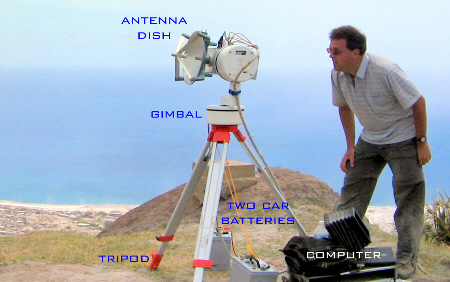 |
|
 |

|

What does a mm-wave instrument look like? Millimetre waves can be used to make radar measurments, so you might imagine a huge dish like those used for radio astronomy or air traffic control. On the other hand, mm-waves can also be used like a thermal camera, an object that can fit in the palm of your hand. In practice mm-wave instruments tend to be of a size that is somewhere in between these two extremes.
You can see the size of AVTIS below.
It is reasonably small and lightweight, which is has
to be since it gets carried around the sides of a volcano.
In fact the heaviest parts of the instrument are the
two car batteries that give the instrument power!
The radar is mounted on a gimbal which
is in turn set up on a surveyors tripod to give the
instrument a steady base. The gimbal is the white object
consisting of two rotating drums: the bottom drum can
turn around from side to side whereas the top drum rotates
up and down. This means that you can point the radar
antenna dish in any direction that you like. One car
battery is used to power the gimbal while the second
is used to provide power for the mm-wave radar signal.
Everything is controlled from a normal laptop computer
which chooses what to scan and keeps a record of the
data.
|
|
|
 |
|
 |

